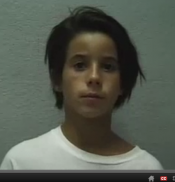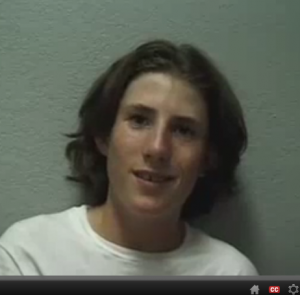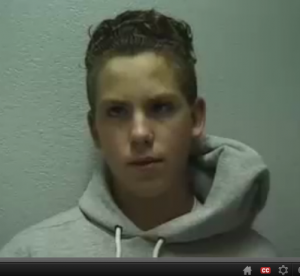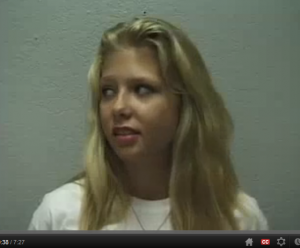Waldorf News
The Waldorf Promise: Working with at-risk youth and high-risk juvenile offenders

“I was caught with receiving stolen property.”
“I just kept on getting in trouble and getting in trouble, so they kicked me out.”
“I got in a fight. Missed my court date. And I had a warrant. They arrested me at school.”
“I smoked pot, so I got kicked out.”
“I’ve been to a lot of schools. I’ve been kicked out of a lot of schools. And of all the ones, this is the best one.”
-12-17 year old students from the Thomas E. Mathews Community School interviewed in “The Waldorf Promise”
Schooling the Imagination
In 1999, Todd Oppenheimer wrote “Schooling the Imagination,” an article on Waldorf education for the Atlantic Monthly. The lengthy and comprehensive article brought national attention to Waldorf education and to the Thomas E. Mathews Community School in Marysville, CA. Under the guidance of Ruth Mikkelsen, the school’s principal, juvenile offenders were being given another chance. A very different kind of “another chance.” Working with children, “one of whom would destroy a class,” the staff and faculty succeeded at bringing “The Waldorf Promise” to a group of mostly forgotten and forlorn young people.
 “Driving down out of the foothills of Yuba County, California, at dawn recently, past wide, flat fruit orchards, abandoned stony gold mines, and endless river levees, I asked my escort, Ruth Mikkelsen, the principal of the local school for juvenile offenders, what the area’s main industry was. “Methamphetamine,” she said with a chuckle. Yuba County lives with some of California’s most dismal demographic statistics. Its unemployment rate is 12.8 percent, twice the state average. Teen pregnancy rates and the proportion of children on welfare are among the state’s highest. The county sends a larger percentage of its adults to prison than any other county in the state. It also has the highest proportion of children classified as low-income (68 percent), and the state’s stingiest dads when it comes to child-support payments.
“Driving down out of the foothills of Yuba County, California, at dawn recently, past wide, flat fruit orchards, abandoned stony gold mines, and endless river levees, I asked my escort, Ruth Mikkelsen, the principal of the local school for juvenile offenders, what the area’s main industry was. “Methamphetamine,” she said with a chuckle. Yuba County lives with some of California’s most dismal demographic statistics. Its unemployment rate is 12.8 percent, twice the state average. Teen pregnancy rates and the proportion of children on welfare are among the state’s highest. The county sends a larger percentage of its adults to prison than any other county in the state. It also has the highest proportion of children classified as low-income (68 percent), and the state’s stingiest dads when it comes to child-support payments.
As we entered Marysville, the county seat, we passed a scattering of burnt-out storefronts bandaged with dry, broken boards — reminders that until the 1950s this town was locally famous for its rich economy of bars, brothels, opium dens, and gambling houses. Descendants of those days now fill Ruth Mikkelsen’s classrooms at Thomas E. Mathews Community School. “If you take all the kids who are being thrown out of school and put them in one room, those are the kids we have,” Mikkelsen said. “One of those kids in a normal class will pretty much destroy that class.”
It was easy to see what she meant. When we pulled up to the school, a group of boys playing basketball on a crumbling court out front were guarding each other with real hostility. Inside, a dozen boys and girls, dressed in the school’s official uniform of blue jeans and white T-shirts, jostled and sassed each other in the tiny common room. One hulking skinhead leaned against the wall, alone, slump-shouldered, quiet, angry.
Underneath this toughness, one could see signs of softness and hope. Before I’d even started exploring, Gary, a skinny fourteen-year-old, spontaneously grabbed me for a quick tour of what I had come to watch: how the Waldorf-school movement, an old, Austria-bred system of private education, is working in a new venue — a hard-boiled public institution for troublemakers. After introducing me to each of his teachers, Gary walked me past the primary tools of the Waldorf day: the recorders every student learns to play, the numerous paintings and art projects, and a pile of “main lesson books” — lengthy creative reports by students on their studies in each academic subject, which they must generate every few weeks.
 Later, during an English class, I noticed a fifteen-year-old I’ll call Robert waving his hand desperately. A small boy with an angelic walnut-brown face, Robert had been expelled from his previous school for smoking marijuana; soon after his arrival at Mathews, he jumped out the probation officer’s window and ran away. On the day I visited, Robert sat attentive throughout a two-hour class. When the teacher finally called on him, he flawlessly recited six lines memorized from The Merchant of Venice. In the early days, Evelyn Arcuri, the teacher, said later, when she asked the students to return their materials, “they would just toss stuff at me. Now there’s better control. They’re more engaged.” I noticed something similar. One twelve-year-old boy sat with me after school, regaling me, in enthusiastic detail, with a creative mixture of Greek and Roman history. The boy could barely read, but he’d been inspired by the oral storytelling that Waldorf teachers emphasize. These roughnecks even like Waldorf’s focus on art. Thomas, an outgoing and restless seventeen-year-old, had found that when he was forced to draw pictures of stories he had read or heard, “you get more visual ideas of what you’re doing.” Arcuri believes she can see that the students are learning more from what they draw. “This year kids are saying, ‘Can I take this home?’ We never had that happen before.” – Todd Oppenheimer, from “Schooling the Imagination”
Later, during an English class, I noticed a fifteen-year-old I’ll call Robert waving his hand desperately. A small boy with an angelic walnut-brown face, Robert had been expelled from his previous school for smoking marijuana; soon after his arrival at Mathews, he jumped out the probation officer’s window and ran away. On the day I visited, Robert sat attentive throughout a two-hour class. When the teacher finally called on him, he flawlessly recited six lines memorized from The Merchant of Venice. In the early days, Evelyn Arcuri, the teacher, said later, when she asked the students to return their materials, “they would just toss stuff at me. Now there’s better control. They’re more engaged.” I noticed something similar. One twelve-year-old boy sat with me after school, regaling me, in enthusiastic detail, with a creative mixture of Greek and Roman history. The boy could barely read, but he’d been inspired by the oral storytelling that Waldorf teachers emphasize. These roughnecks even like Waldorf’s focus on art. Thomas, an outgoing and restless seventeen-year-old, had found that when he was forced to draw pictures of stories he had read or heard, “you get more visual ideas of what you’re doing.” Arcuri believes she can see that the students are learning more from what they draw. “This year kids are saying, ‘Can I take this home?’ We never had that happen before.” – Todd Oppenheimer, from “Schooling the Imagination”
Ruth Mikkelsen teaches on the “Professional Development for Teachers of At-Risk Youth” at Rudolf Steiner College in Fair Oaks, CA. The course focuses on the innovative model program that was developed at the Yuba County Court and Community Schools. The course helps teachers working with at-risk youth to develop their own personal capacities in the arts, literature, music and movement as well as learning how Waldorf education can help meet their students.
“On the last day of school, two fifteen year old boys-one Hispanic, the other Hmong-played a Mozart duet on their recorders. Both had been expelled from public schools for violent acts, constant failure in class, and refusal to follow directions. But their music lessons were rigorous. They had never worked so hard on anything. When they finished playing their duet before and audience of 45, classmates cheered and they even clapped for themselves. It was a miracle.” –Ruth Mikkelsen, former principal, Yuba County Court and Community Schools
Reclaiming their human rights
Evelyn Arcuri, sums up her experience as a teacher:
“I teach the broken, the fragile; those that have been tossed aside during the most pivotal years of adolescence. All of our students are being processed in one way or another through the juvenile court system. Many are wards of the state; all are on probation. Most will not get a second chance in the public school system. Some of the students have committed the most heinous of crimes including assault with a deadly weapon, rape, theft, burglary. They are frequently without remorse for their crime. They range in age from 11 to 18 and are mostly boys, although our female population appears to be growing year by year. They come from every racial background, reflecting the racial mix of the town of Marysville. Most are from low socioeconomic backgrounds…”
 “Day one: One of the older students blurted out, “This is bogus, can we sit down now!” Several students nodded in agreement and plopped down in their chairs. I explained that we would be saying an opening verse daily and that I expected all to participate. When they were all back on their feet we read the verse again, this time with a little more life, and without any complaints. I tried to keep the mood lighthearted, but inwardly I was already feeling unsure and tempted to go directly to some safe worksheet to avoid further embarrassment. Instead, I had the students introduce themselves and then had them move to the courtyard where I introduced the bean bag name game. The students form a circle and then the facilitator throws the first bean bag to a student while calling his/her name and then that student tosses to another student while calling his/her name and so forth. Chaos reigned the first time around. The bag was flung every which way and finally I had to stop the game when the younger boys began wildly hurling it at each other. Once, I asked for the game to stop and made the mistake of asking for the bean bags. I was immediately pelted from every direction with bean bags…”
“Day one: One of the older students blurted out, “This is bogus, can we sit down now!” Several students nodded in agreement and plopped down in their chairs. I explained that we would be saying an opening verse daily and that I expected all to participate. When they were all back on their feet we read the verse again, this time with a little more life, and without any complaints. I tried to keep the mood lighthearted, but inwardly I was already feeling unsure and tempted to go directly to some safe worksheet to avoid further embarrassment. Instead, I had the students introduce themselves and then had them move to the courtyard where I introduced the bean bag name game. The students form a circle and then the facilitator throws the first bean bag to a student while calling his/her name and then that student tosses to another student while calling his/her name and so forth. Chaos reigned the first time around. The bag was flung every which way and finally I had to stop the game when the younger boys began wildly hurling it at each other. Once, I asked for the game to stop and made the mistake of asking for the bean bags. I was immediately pelted from every direction with bean bags…”
“I spoke with the student who thought everything was “bogus” on Monday about his experience during the week. He said he now felt fine with the program and was having fun, though he was still trying to get ‘the rhythm of it all…’”
“I honestly believe that the introduction of music, art and movement throughout our curriculum will help our students discover their spirituality and reclaim their basic human right of life, liberty and the pursuit of happiness which was snatched away sometime during their childhood.” –Evelyn Arcuri from “Implementing the Integrated Curriculum with Focus on Active Learning and the Arts”
Learn more about the Professional Development Course for Teachers of At-Risk Youth at Rudolf Steiner College in Fair Oaks, CA from Juny 8-20, 2012.
 The Art of Administration and Leadership
The Art of Administration and Leadership Full-Time Teacher Education
Full-Time Teacher Education Association for a Healing Education
Association for a Healing Education Flexible preparation for your new grade
Flexible preparation for your new grade Roadmap to Literacy Books & Courses
Roadmap to Literacy Books & Courses Grade Level Training in Southern California
Grade Level Training in Southern California Summer Programs - Culminating Class Trips
Summer Programs - Culminating Class Trips Waldorf EC Training & Intensives in Canada
Waldorf EC Training & Intensives in Canada Transforming Voices Worldwide
Transforming Voices Worldwide Apply Today: New Cohort Starts Nov. 2025
Apply Today: New Cohort Starts Nov. 2025 Immersive Academics and Arts
Immersive Academics and Arts ~ Ensoul Your World With Color ~
~ Ensoul Your World With Color ~ The Journey is Everything
The Journey is Everything Bay Area Teacher Training
Bay Area Teacher Training Bringing Love to Learning for a Lifetime
Bringing Love to Learning for a Lifetime Waldorf-inspired Homeschool Curriculum
Waldorf-inspired Homeschool Curriculum Everything a Teacher Needs
Everything a Teacher Needs Jamie York Books, Resources, Workshops
Jamie York Books, Resources, Workshops Discovering the Wisdom of Childhood
Discovering the Wisdom of Childhood Storytelling Skills for Teachers
Storytelling Skills for Teachers Middle School Science With Roberto Trostli
Middle School Science With Roberto Trostli Train to Teach in Seattle
Train to Teach in Seattle Art of Teaching Summer Courses 2025
Art of Teaching Summer Courses 2025 Caring for All Stages of Life
Caring for All Stages of Life Dancing for All Ages
Dancing for All Ages Space speaks. Its language is movement.
Space speaks. Its language is movement. Quality Education in the Heartland
Quality Education in the Heartland RSS Feeds
RSS Feeds